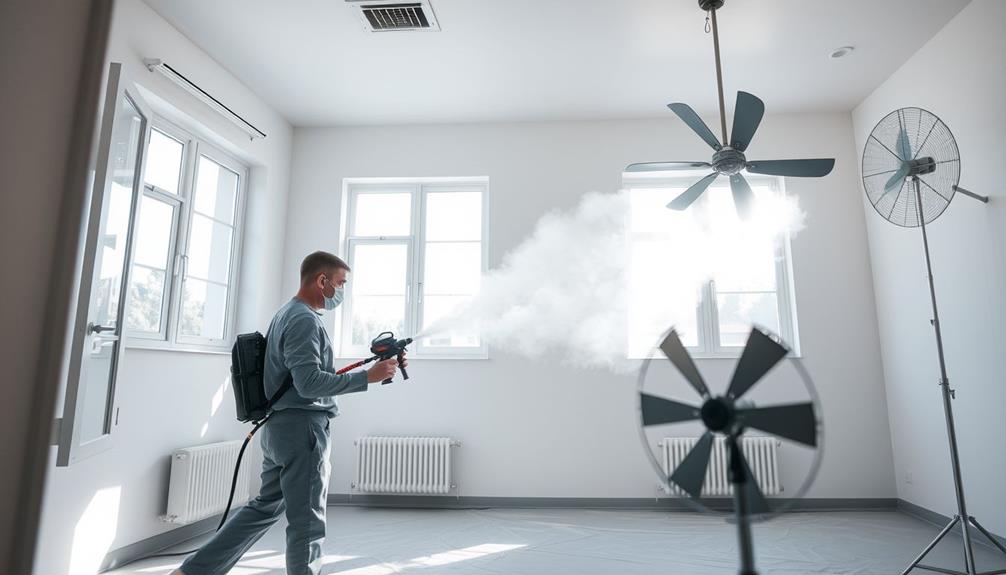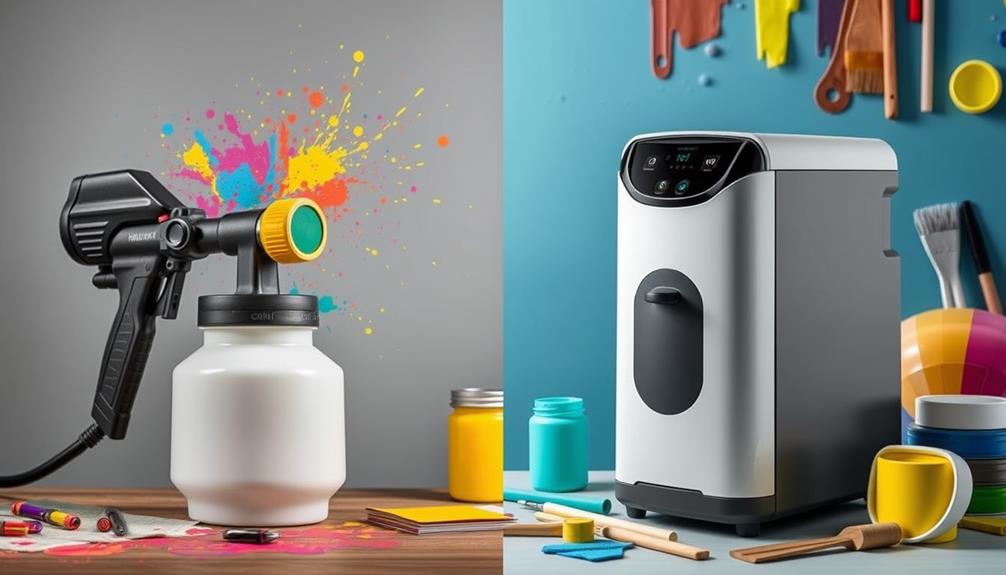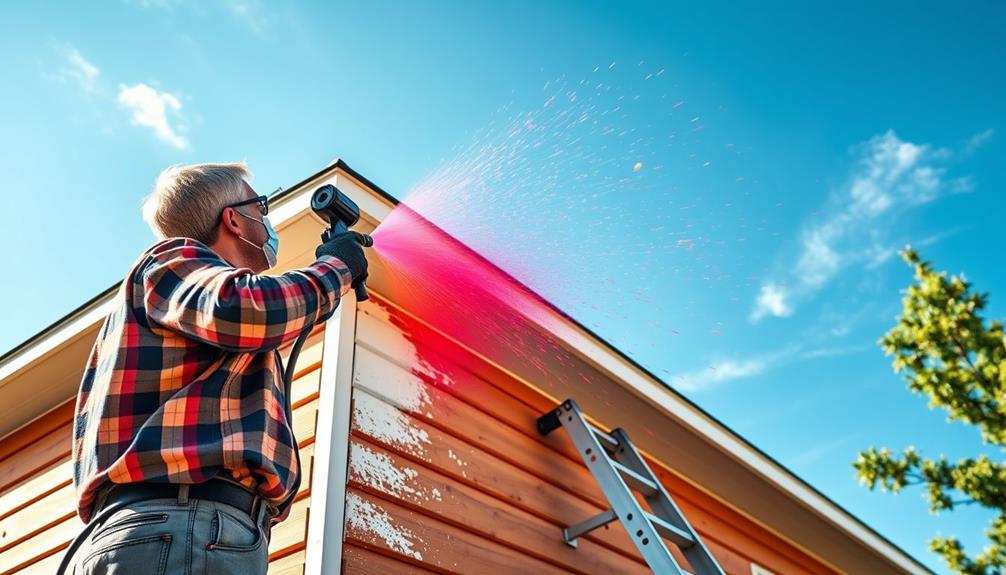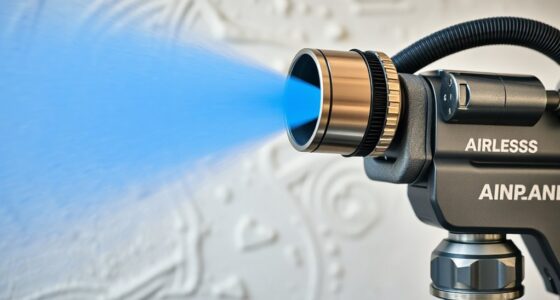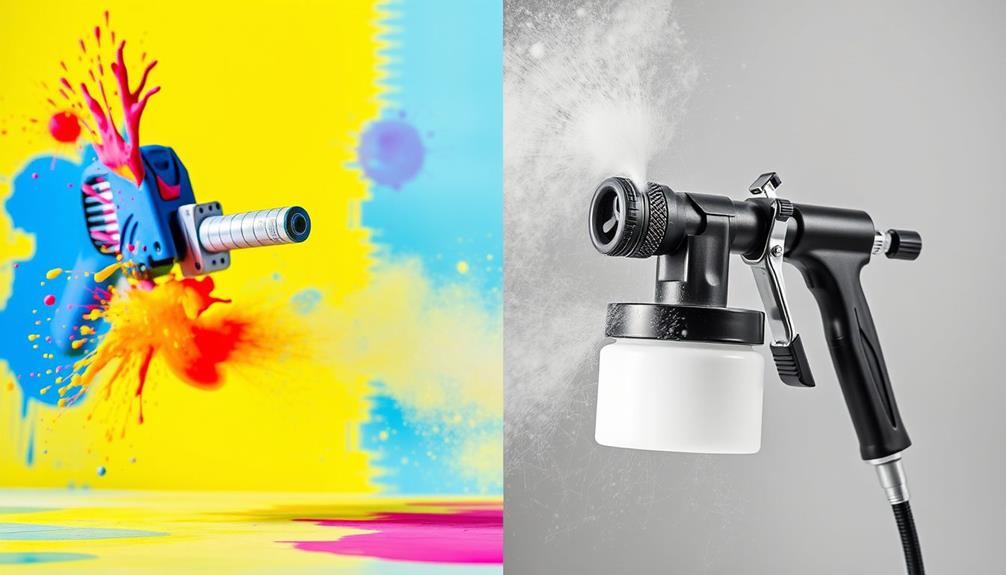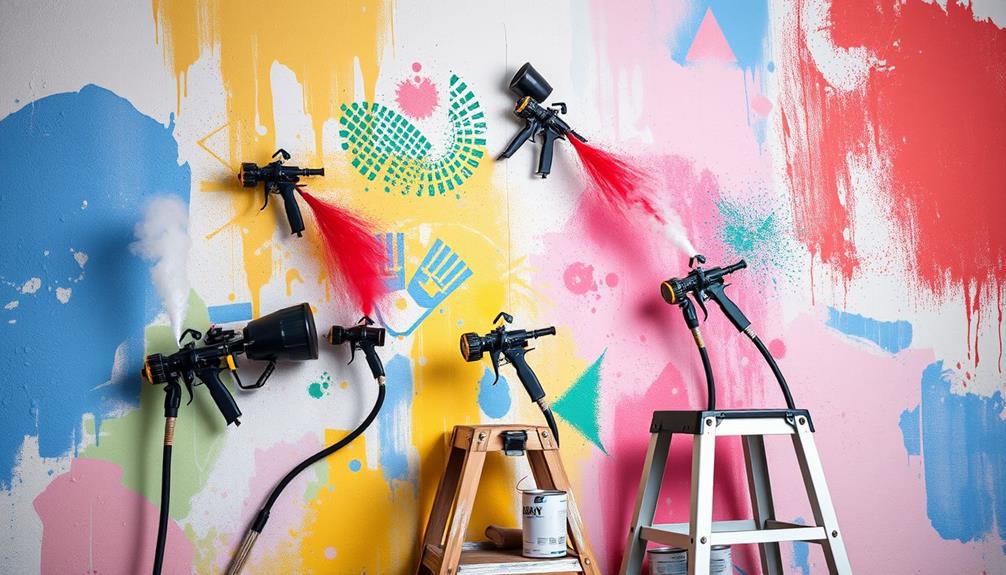To properly ventilate when using an airless paint sprayer indoors, start by opening all windows and doors to create natural airflow. Remove any furniture or items that might trap fumes. Set up fans to blow air toward exits, enhancing circulation. Monitor the air quality and consider using a gas detector for safety. Wearing a respirator with organic vapor cartridges is essential to protect your lungs. Aim for 4-6 air changes per hour to keep the air fresh. Following these steps will guarantee a safer environment; you'll uncover more essential tips and techniques as you explore further.
Key Takeaways
- Open all windows and doors to promote natural airflow and disperse harmful paint fumes effectively.
- Use multiple fans positioned toward exits to enhance air circulation and fresh air intake.
- Monitor oxygen levels with a gas detector to ensure safety in confined spaces.
- Wear high-quality respirators and safety goggles to protect against harmful fumes and paint splatter.
- Employ air purifiers with HEPA filters to improve air quality by reducing harmful particles and VOCs.
Importance of Ventilation
Ventilation is essential when you're using an airless paint sprayer indoors. Proper ventilation helps disperse harmful paint fumes and maintains air quality, which is vital since many paints contain volatile organic compounds (VOCs) that can pose health risks.
Without adequate airflow, the concentration of these fumes can increase, leading to respiratory irritation and potential long-term health issues. Utilizing air purifiers can further enhance indoor air quality by reducing allergens and harmful particles, making it a smart choice for painting projects.
To enhance airflow, you should open windows and doors, allowing fresh air to circulate and push out stale air. Using fans to direct airflow toward exits can effectively carry away fumes, ensuring a continuous exchange of fresh air during the spraying process. This not only protects your health but also improves the finish of your project. Stagnant air can cause paint to settle on surfaces, ruining your hard work.
OSHA recommends monitoring oxygen levels in confined spaces to prevent displacement hazards while using airless sprayers. By prioritizing ventilation, you create a safer working environment, minimizing health risks associated with VOCs and ensuring your painting job goes smoothly.
Preparing the Space
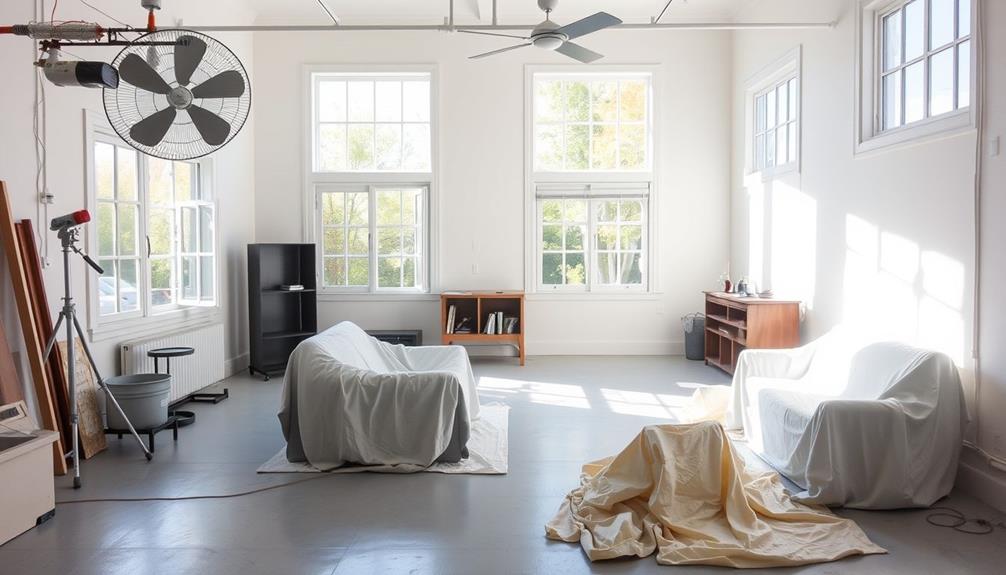
To create a safe and efficient painting environment, you'll need to prepare the space before using your airless paint sprayer. Start by opening all windows and doors for ideal ventilation, which allows fresh air to flow through the workspace.
Next, remove items that can trap fumes. This includes furniture, rugs, and wall hangings. This step enhances air circulation and helps prevent paint damage. Set up fans to direct airflow towards exits, dispersing fumes and improving ventilation while you work.
You should also cover air vents with plastic sheeting to keep paint particles from entering the HVAC system while still allowing for adequate airflow. Additionally, create barriers with plastic sheeting to contain overspray, ensuring that other parts of your home remain unaffected by fumes.
Here's a quick summary of the preparation steps:
| Step | Action | Purpose |
|---|---|---|
| Open windows/doors | Enhance ventilation | Allow fresh air in |
| Remove items | Improve air circulation | Prevent fume traps and damage |
| Set up fans | Direct airflow | Disperse fumes effectively |
Taking these steps will set you up for a safer and more effective painting experience.
Effective Airflow Techniques
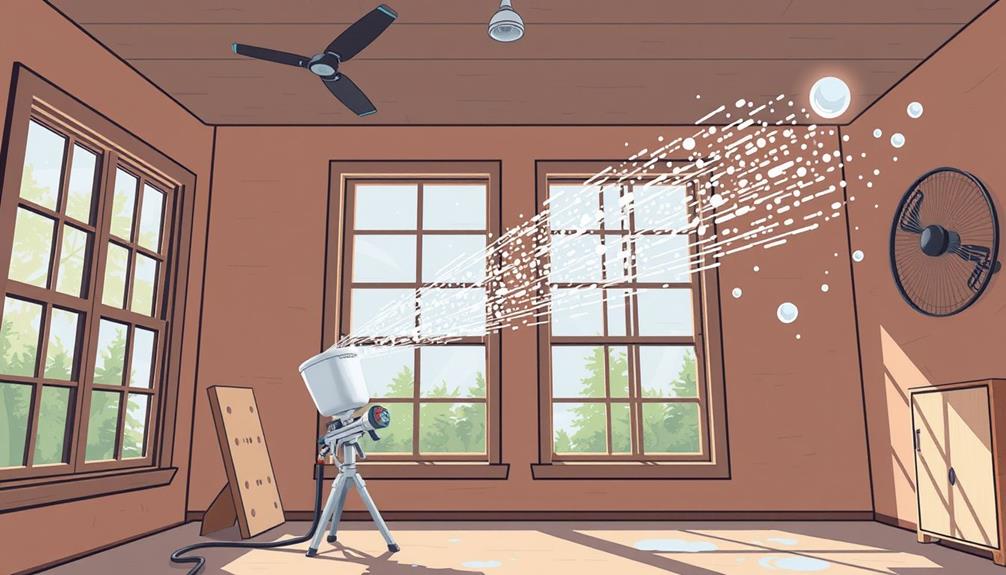
Creating effective airflow during your painting project is vital for your safety and comfort. Start by positioning fans to create a directed airflow toward exits. This setup helps disperse harmful fumes and keeps your environment safe while you spray.
Additionally, guaranteeing proper ventilation not only enhances comfort but also promotes an ideal working environment for using an airless paint sprayer. Don't hesitate to use multiple fans; they enhance air circulation and make sure fresh air is continuously drawn in, pushing out toxic vapors.
Whenever possible, open windows and doors to facilitate natural airflow. This simple step greatly reduces the concentration of airborne chemicals, making your workspace less hazardous.
If you're working in an enclosed area, it's essential to monitor oxygen levels using a gas detector. This precaution can help you avoid displacement hazards that occur when paint fumes accumulate.
Safety Equipment Recommendations
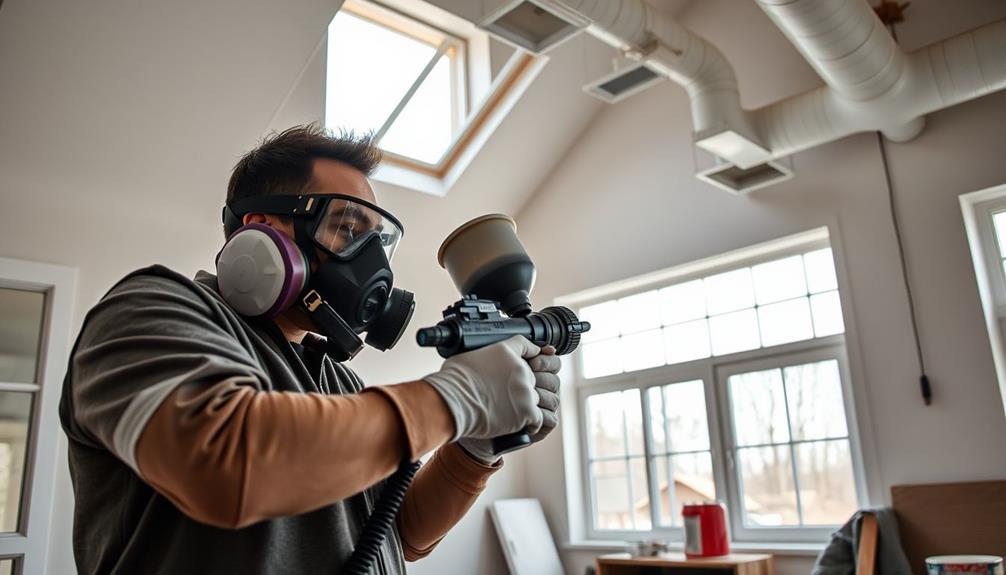
Using the right safety equipment is essential when operating an airless paint sprayer indoors. Start by wearing a high-quality respirator equipped with organic vapor cartridges. This will protect you from harmful fumes released during the painting process, similar to how proper clogging remedies can prevent unwanted issues.
Safety goggles are also vital; they'll shield your eyes from paint splatter and airborne particles, ensuring you can work without worry.
Don't forget about your hands—use solvent-resistant gloves to guard against paint exposure. Disposable gloves are a good choice because they provide a barrier to protect your skin while being easy to discard after use.
Additionally, consider wearing comfortable knee pads if you'll be working on lower surfaces; they'll help protect your knees during those longer spray jobs.
Make sure all your protective gear fits properly and is in good condition. Ill-fitting equipment can compromise your safety, leaving you vulnerable to potential hazards in your workspace.
Monitoring Air Quality
While you're focused on achieving a perfect finish with your airless paint sprayer, it's essential to keep an eye on air quality to protect your health.
Monitoring the air quality guarantees safe levels of volatile organic compounds (VOCs) and particulate matter, minimizing health risks associated with prolonged exposure.
Additionally, understanding the importance of key factors in choosing a home cleaning service can also help you maintain a clean and safe environment while you work.
Here are some effective strategies for monitoring air quality:
- Use a Digital Monitor: Invest in a digital air quality monitor to track levels of VOCs and particulate matter, ensuring they stay below OSHA's recommended thresholds.
- Ventilation: Guarantee adequate ventilation by opening windows and using exhaust fans. Aim for at least four to six air changes per hour in your workspace.
- Check Oxygen Levels: Regularly monitor oxygen levels, especially in confined spaces, to avoid the risk of asphyxiation due to inadequate ventilation.
- Air Purification Systems: Consider using air purification systems with HEPA filters to reduce airborne contaminants and improve overall air quality during your painting project.
Managing Fumes and Odors
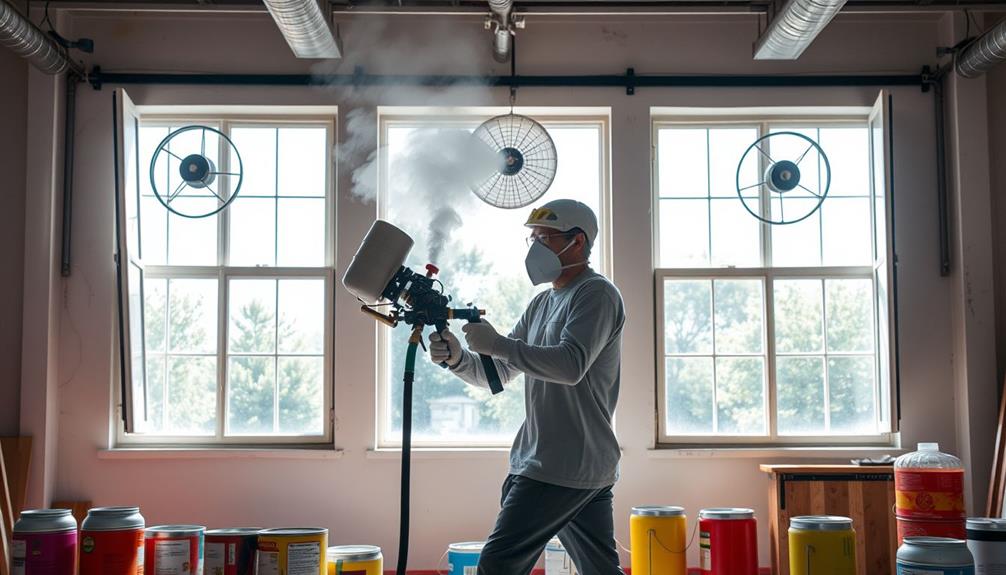
Managing fumes and odors during indoor painting projects is vital for your safety and comfort. To achieve this, guarantee adequate ventilation by opening windows and doors to facilitate airflow, which helps disperse harmful fumes produced during airless paint spraying.
Additionally, using the right Graco FFLP Fine Finish Low Pressure Reversible Tip can help minimize overspray and, consequently, reduce the amount of fumes released into the air. Position fans strategically to direct airflow towards exits, effectively pushing out fumes and enhancing air circulation in your workspace.
If you have exhaust fans available, use them, as they can greatly improve the removal of paint odors and reduce the concentration of volatile organic compounds (VOCs) in the air.
It's imperative to monitor indoor air quality continuously, so consider using air quality sensors to detect levels of hazardous fumes while painting. Avoid spraying in enclosed spaces without proper air exchange; doing so can lead to a dangerous buildup of toxic fumes, posing serious health risks.
Post-Spraying Cleanup Tips
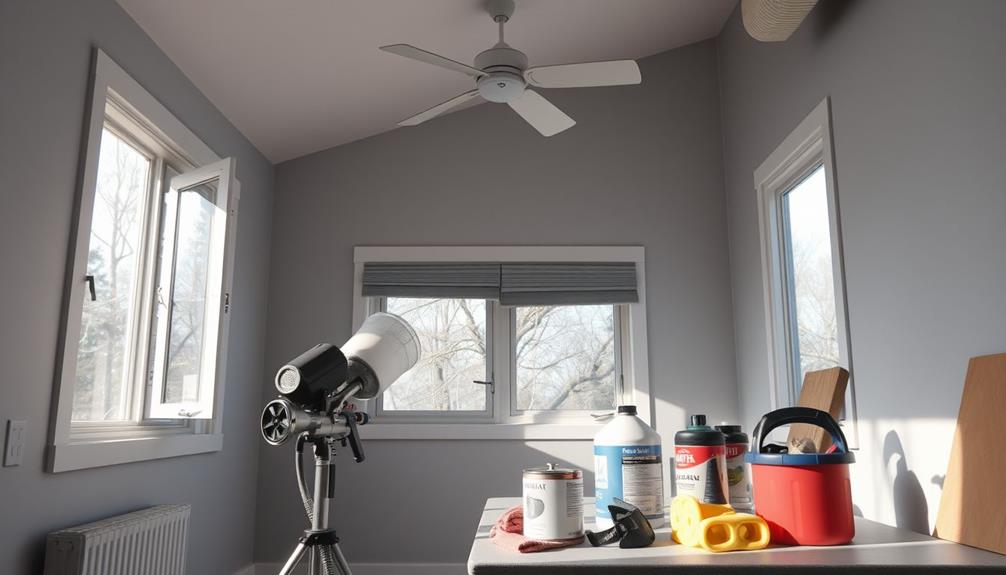
Once you've finished spraying, it's essential to clean up properly to maintain a safe and tidy workspace. This includes ensuring that all surfaces are free from overspray and considering the use of safety glasses to protect your eyes during the cleanup process.
Start by disposing of any used materials and thoroughly cleaning your equipment to avoid future issues.
Dispose of Used Materials
To guarantee a safe and environmentally friendly cleanup after using an airless paint sprayer indoors, you should start by properly disposing of all used materials.
It's also essential to make certain proper ventilation during your painting project to minimize inhalation of fumes and improve air quality.
Here are some essential tips to help you through the process:
- Dry Completely: Always allow used paint cans, brushes, and sprayers to dry completely before disposal. This prevents spills and leaks that can harm the environment.
- Check Local Regulations: Research your local guidelines for disposing of hazardous waste, including paint and solvents. Different areas have specific methods you need to follow.
- Store or Donate Leftover Paint: Use empty paint containers to securely store any leftover paint for future touch-ups. Alternatively, consider donating it to local community organizations that accept paint.
- Recycle When Possible: If your plastic or metal paint containers are clean and empty, recycle them. Many recycling centers accept these materials, promoting responsible disposal.
Remember to wear your protective gear while handling all materials, and make certain that any used rags or items are disposed of in a sealed bag to reduce fire risks.
Following these steps will help you effectively dispose of used materials and maintain a safe environment.
For more information on maintaining a safe environment during projects, check out weight loss strategies.
Clean Equipment Thoroughly
After confirming that all used materials are disposed of properly, it's important to focus on cleaning your airless paint sprayer thoroughly.
Start by using the appropriate cleaning solution immediately after use to prevent paint residue buildup. A thorough cleaning routine, akin to maintaining a self-cleaning mechanism in a vacuum, will help guarantee your equipment stays in prime condition.
Disassemble the sprayer according to the manufacturer's instructions, paying special attention to the tip, filters, and pump. A thorough cleaning of these parts is essential to remove any paint particles.
Next, rinse the components thoroughly with water or a solvent, depending on the type of paint you've used. Make sure all parts are free from paint before reassembling.
During this process, inspect the sprayer for any signs of damage or wear. Addressing these issues promptly will help maintain longevity and efficiency, ensuring your equipment remains in peak performance for future projects.
Once cleaned, store the sprayer in a dry, dust-free environment to prevent contamination and potential damage.
This care routine not only keeps your airless paint sprayer in top shape but also enhances its reliability for your next painting job.
Restore Work Area
Restoring your work area after using an airless paint sprayer is essential for maintaining a tidy and inviting space.
A well-organized environment enhances creativity and productivity, leading to better results in future projects.
Follow these steps to guarantee everything's clean and organized:
- Remove Masking Tape: Wait at least 24 hours for the paint to cure before carefully removing any masking tape. This helps achieve clean edges and prevents damage to your freshly painted surfaces.
- Restore Furniture: Once the paint is fully dry, return your furniture and fixtures to their original spots. Handle them carefully to avoid smudging or sticking to the paint.
- Dispose of Materials: Properly dispose of used drop cloths, masking tape, and other disposable materials according to local regulations. This promotes effective waste management and contributes to a breathtaking destination for your creativity.
- Conduct Final Inspection: Finally, do a thorough inspection of the area. Check for any overspray or missed spots, and touch up as needed to achieve a polished finish.
Frequently Asked Questions
How to Spray Paint Indoors Without Ventilation?
If you're spraying paint indoors without ventilation, consider using low-VOC paints, employ fans to circulate air, and take regular breaks outside. Always prioritize your health by minimizing exposure to harmful fumes during the process.
Can You Use an Airless Sprayer Indoors?
Absolutely, you can use an airless sprayer indoors, but you've gotta guarantee proper ventilation. Open those windows, fire up some fans, and protect your space. Safety first, and don't forget your gear!
How Do You Prepare a Room for an Airless Paint Sprayer?
To prepare a room for an airless paint sprayer, clear the space of furniture, cover floors with drop cloths, mask off areas you don't want painted, and remove outlet covers for a clean finish.
How to Ventilate a Room for Spray Painting?
To ventilate a room for spray painting, you'll want to open windows and doors for cross-ventilation. Position fans to direct fumes outside and consider using exhaust fans to enhance airflow and maintain safety.
Conclusion
Ventilating when using an airless paint sprayer indoors isn't just smart; it's essential for your health and the quality of your work. Think of it like opening a window to let clean air into a stuffy room—it transforms the atmosphere. Just as a gust of clean air can lift your spirits, proper ventilation keeps you safe and guarantees your paint job looks stunning. So, always prioritize airflow; it's the key to a successful and enjoyable painting experience.
